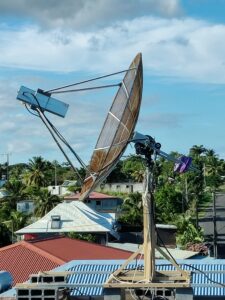My Beginning in 23cm moonbounce
2020 was my start in 2m EME activity. 2021 was the start in 23cm. 23cm activity is the second most popular on EME and I was very excited to start on this band. This band is very popular since the launch of the Icom 9700 who is 23cm almost ready. Almost ready because you have to add a GPSDO to stabilize the oscillator which makes otherwise digital qsos impossible. I am using the ICOM IC-9700 Reference Injection Board and Mini Precision GPS Reference Clock from Leo Bodnar that doing a really good job and let have a +/- 1 or 2 Hz qso precision via the Moon doppler.
 This first step made, the choice of the antenna is like always the most important. Unfortunately, I couldn’t find a TVRO dish on my island and have to buy a mesh dish and a BIG-RAS rotator to move it at RFHamDesign. I have build a bracket and installed it on my roof. Then, I stated to build the dish. That was quite easy because the manual is not very detailed but after a few dozen hours of work and nearly 200 rivets installed, the dish was mount on the rotator. I have found a fitness barbell and cut it in the middle and added weight plates to balance. The mechanical part is done and I can start the
This first step made, the choice of the antenna is like always the most important. Unfortunately, I couldn’t find a TVRO dish on my island and have to buy a mesh dish and a BIG-RAS rotator to move it at RFHamDesign. I have build a bracket and installed it on my roof. Then, I stated to build the dish. That was quite easy because the manual is not very detailed but after a few dozen hours of work and nearly 200 rivets installed, the dish was mount on the rotator. I have found a fitness barbell and cut it in the middle and added weight plates to balance. The mechanical part is done and I can start the easiest hardest part now 🙂
I have installed the source, a OK1DFC septum feed from RFHamDesign. The particularity is that there is 2 ports (TX and RX) and produce a circulator LHCP/RHCP without any loss. This way, we can directly connect a LNA but I have to separate coaxial cable with a relay at transceiver output. The choice of a very low noise figure LNA is very important and can have a huge difference. My choice was to a VHFDesign LNA with a very low noise figure < 0.3 dB. The parts between N source to the LNA should be realised very attentively. Each part (adaptator, isolation relay, …) can have a very high impact : 0,1 dB before LNA can be 1 dB loss
This part done, we can start to check dish positioning. The ON0EME beacon is currently down but we have a very good source half of day to test your reception : The sun emit noise and we can be measure difference with quiet sky and adjust to best level the azimuth and elevation and the feed depth. This last point have let me spend multiple hours to adjust noise level 0.,1 dB by 0,1 dB but result is not too bad and I have good RX performances.
First station received was HB9Q with is 10m dish. I done this qso with only Icom 9700’s 10 W. Now, I need an amplifier but the solution is not so easy. Many station going to 23cm and electronic part market is complex due to pandemic situation. I have success with 15 stations with 15 big guns stations but I was very frustrated because I was able to receive smaller stations.
I finally ordered a w6pql 600W pallet and build the amplifier and have successfully contacted more than one hundred stations. At the end of 2021, you can find amplifier parts at W6PQL website, VHF Design and PE1RKI. Beko seems to be the only completed amplifier on the market.

What’s next ? During the ARRL EME contest, I was able to make 2 qsos with OK1KIR, DG5CST in CW. Next challenge will be to do more CW qsos and I will build a 3m dish.
Dear OM,
I am with great interest studying your various posts on your website. One question is how you find geographical north direction, which must be of high importance working with narrow radiation patterns from your disc.
An advice will be most helpful.
Vy 73 de oz1itm